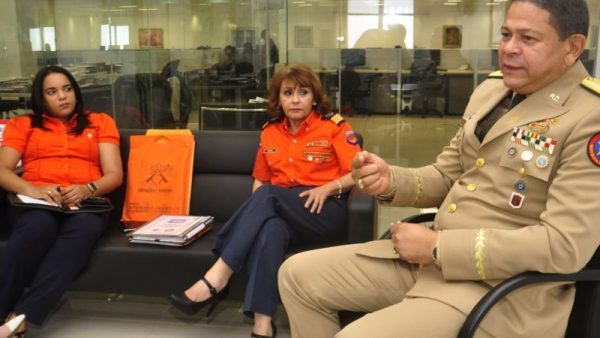
The Civil Defense is no longer that entity that waits for a rainstorm to happen to get volunteers to don their orange polo shirts to assist people. He said that an endowment of technological equipment has enabled them to define the protocols better to respond to earthquakes, hurricanes and flooding. “We are prepared to assist the population,” Civil Defense director Brigadier General Rafael Antonio Carrasco Paulino told Hoy newspaper.
Supervision and follow-up are now also constant, he says. He explained that after the earthquake in Haiti 10 years ago, plus the earthquakes now in Puerto Rico, Civil Defense is always on alert.
However, when asked if he feels that the population knows what to do in the event of an earthquake, he admits that preparation is needed. He calls for responsibility to be taken on by the citizens themselves. He says that the population lacks awareness of what to do. He says citizens are too used to having everything done for them by the government.
Dr. Bélgica Miguelina Tactuk, director of the National School of Risk Management, says that the first response is the one given at home. She said families and companies need to have a plan. “People have to understand that no matter how much equipment we have, the first response will be at home,” she says. She explains that next comes the institutional response.
In that sense, both she and General Carrasco emphasize the need for each household to have an emergency backpack with a first aid kit, bottled water, non-perishable food, personal identification documents, flashlights and whistles, battery-powered radio, multi-purpose knife, toiletries, tape, blankets and warm clothing, among other items.
They also point out the importance of companies and public and private institutions having emergency evacuation routes designed and having first aid kits on hand.
General Carrasco says they are equipped with vehicle extrication equipment donated by Japan. This allows for the rapid rescue of people in cases where they are trapped by landslides or vehicle collisions.
However, General Carrasco reports that they do not have buoys to detect tsunamis, although they have formed emergency brigades in several institutions, to act in this eventuality.
General Carrasco says the Civil Defense works as a team with the National Emergency System (911) for water, mountain rescue and fire evacuations, among other operations.
“For example, when there is a fire, we make perimeter fences so that firefighters can operate, and we help people evacuate,” he explained. “It is not the same for a person to accept help from an uniformed soldier, which some people see as repression, as from a person from the Civil Defense, attired in the orange polo, whom people already identify as the color of the rescue,” says the director.
The country is now using geo-referencing spatial positioning for shelters. Also, the Integrated National Information System (SINI) connects the Civil Defense with 15 other institutions to keep up to date on the country’s risks. From the Situation Room, the Civil Defense can be in contact with the 32 Civil Defense provincial directors.
Carrasco says they count on around 14,000 volunteers. These people are not after payment or economic benefits, he said. “Immediately we call, they come,” explains the director of Civil Defense. The volunteers now do benefit from the government SENASA medical and life insurance, and the volunteers receive a daily allowance for food that ranges from RD$500 to RD$750.
Read more in Spanish:
Hoy
20 January 2020

